Environmental Conditions change. I am constantly irritated by the absolute failure of forums and gun reviews to illustrate certain failings that sighting systems have.
“Optics are superior in every way, period.”
SEAN WILLIAM SCOTT: YES! THATS AWESOME.
I generally agree, it’s 2019 after all… we have compact nuclear powered scopes which can also draw their luminescence from the sun. You bet your ass hit percentages go up with quality optics, but without adverse conditions are we so sure?
One thing I fail to see discussed often enough is where optics fail. Oh sure, you dropped your ACOG/AIMPOINT and your convoy blew up and a blackhawk landed on it and Larry Vickers blew it up on purpose, and it never lost its zero. Modern optics are damn tuff aren’t they? What would our soldiers be saying about ACOG’s if our war on terror occurred in a jungle environment in constant rain? There are many situations we don’t often consider which could lead to a breakdown of optic effectiveness.
So let’s get started. I wanted to explore more adverse conditions and take some photos for science. I brought out three optics. A Trijicon ACOG, an Atibal 1-4x Variable, and a Holosun “Gold Dot” sight. I mounted a 25 meter zero target at 10 yards. Humidity around 70-75 percent. I attempted to focus the camera on the target with varying levels of success. Read the descriptions to augment the photo. Many times the optic performed a bit better than some photos could capture. So what’s the most common environment that could impact optic effectiveness?
Modern Air Conditioning:
Really? Yes. One point hardly ever discussed is the failure of optics transitioning from a cool, dry environment to a humid environment. You know, going outside. For some shooters in dry climates, this may not be much of an issue. For shooters along the coast with high humidity… It’s something to consider. Indoors, red dots, variables, and prismatics are all fit for duty, but when we make that transition to a humid environment the optic can diminish in clarity and target fidelity. This is especially obvious after rain. Moving from cool indoor AC to outdoors after a summer rain can fog optics within seconds with a light coat of fog.
Light Optical Fog:
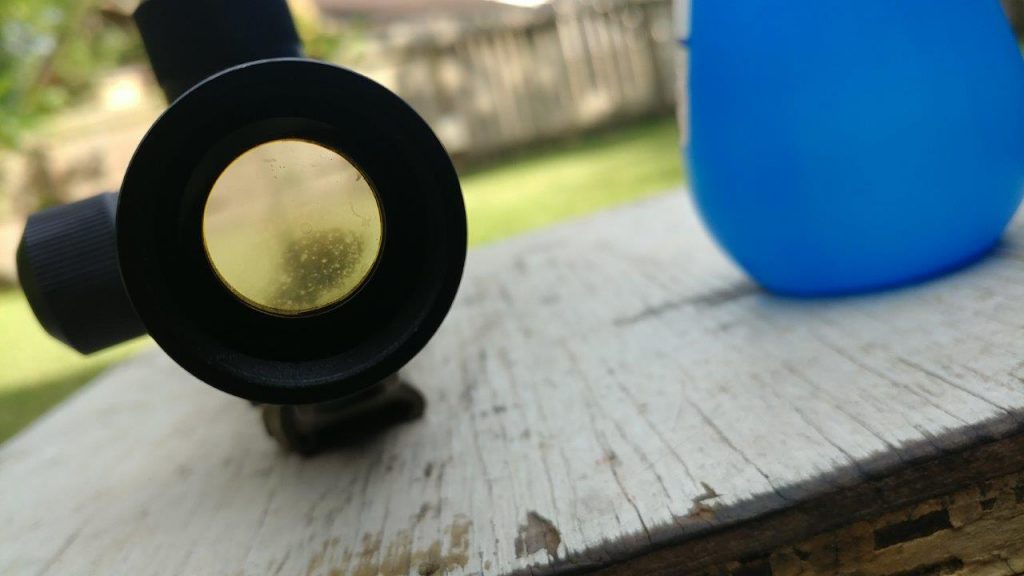
To simulate a light optical fog, I left my optics on a counter below a register, and took them outside from a cool, air-conditioned house. The optics all suffered target fidelity loss. The magnified optics appeared to be looking at a foggy scene on my simulated 100ish yard target. The high contrast black on tan target was still fairly easy to spot. ACOG, slightly foggy target. Variable 1x: Foggy, low target fidelity. Variable 4x: slightly foggy, dimmer than ACOG. Red dot: foggy, low target fidelity. Irons: Full target fidelity.
The Trijicon ACOG lost some fidelity. It was akin to shooting on a foggy morning, but target could still be resolved.
The variable, with its smaller objective lens, gave the shooter a slightly darker image, but the target could still be resolved i guess.
The red dot faired well with a minor loss in fedility immediately after fogging. Of note, the fog fell away from the red dot quickly, and I suspect this is due to the smaller glass windows. They likely reached environmental temperature before the thicker lenses present on the magnified optics.
Within a few moments the optics shook off the condensation, and a brief gust of wind could clear them, with the red dot clearing quicker than either magnified optic. I suppose its due to thinner lenses that warm quicker than the thicker lenses of the magnified optics.
Severe Optical Fog:
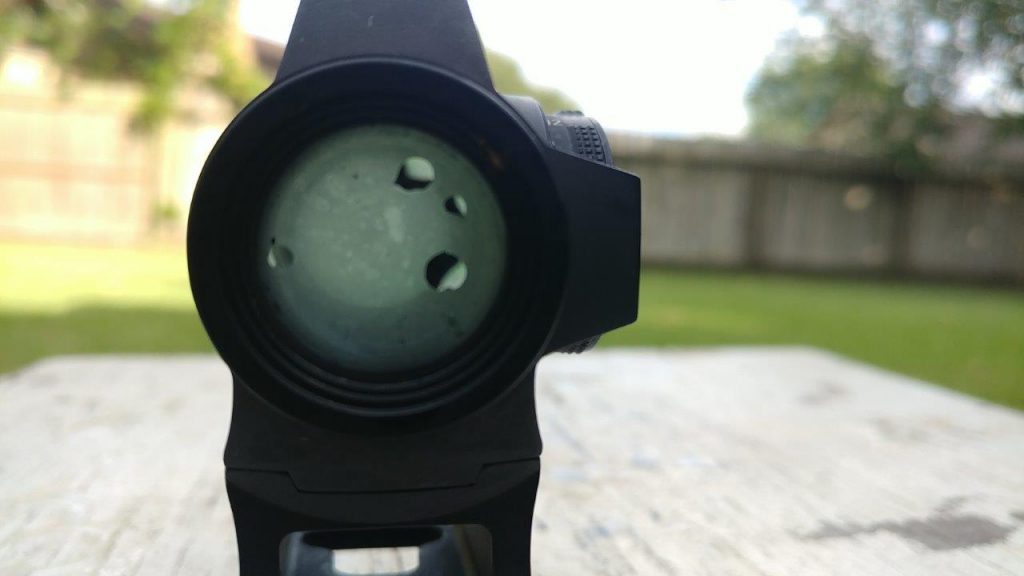
To simulate a severe optical fog, I placed the optics in my fridge for 5 minutes. One situation I suspect could create severe optical fog would be leaving allowing a car AC vent to blast cool, dry air directly on your rifle. Modern AC vents in cars can cool to a duct temperature of 40-50 degrees. Couple these cold temperatures with a humid environment and you can instantly fog an optic. Upon moving outside, all optics fogged instantly. Target fidelity was lost in all optics to the point of being UN-identifiable. This effect was a complete situational failure for both the variable and ACOG. The red dot also lost full target fidelity; however, the “gold dot” (Yes, it’s a gold dot sight) was still visible inside the fogged lenses. This allowed the shooter to use the red dot as an occluded eye gun sight with an eye on the target focus. I would say, despite worst case scenario fog, the dot sight was still usable. Irons were again, unaffected and allowed full target fidelity.
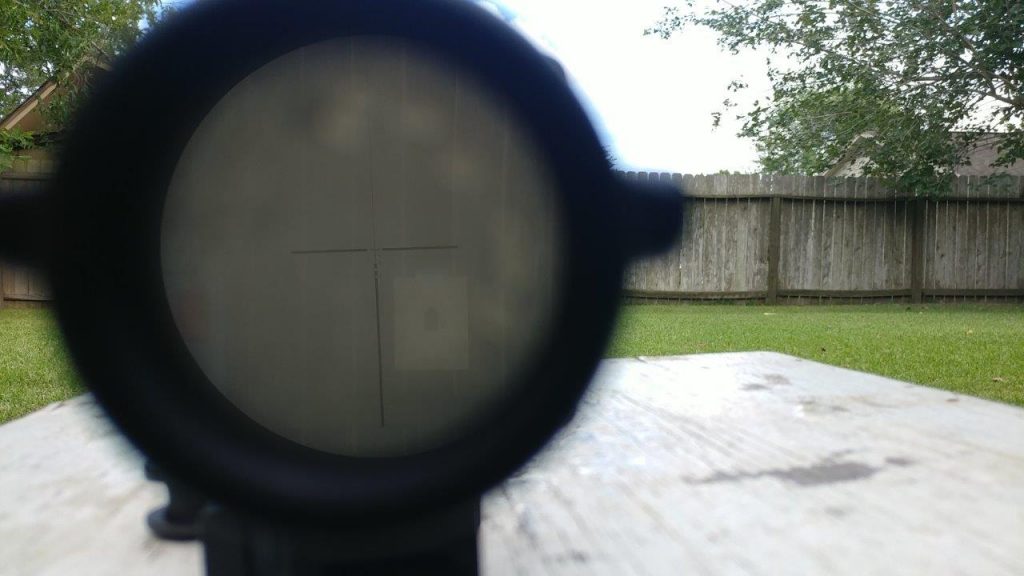
ACOG: Severe lens fog, very dark image. Attempt to wipe lenses with thumb allowed only momentary relief. The optics fogged again within seconds. This would continue until the optics temperature approached the outdoor temperature. The ACOG stayed fogged excessively for several minutes.
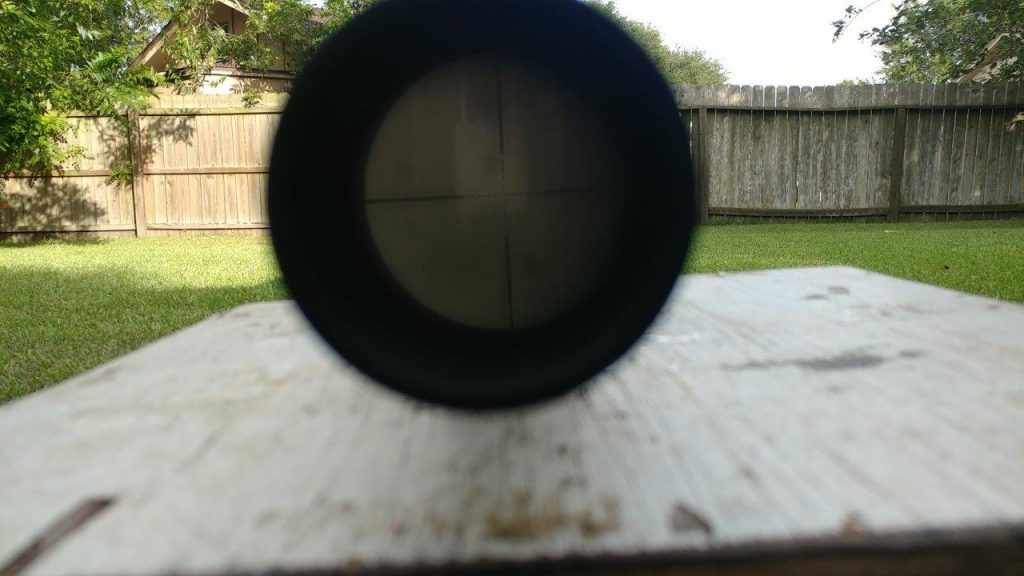
Variable: The variables image deteriorated more so than the ACOG. The image is darker, and it too suffered the same issues. Despite wiping the optic, it continued to fog for several minutes. At 1X the optic was still off base. With a dark image on a dark reticle, it was hard to shoot with both eyes open since the reticle was quite subdued.
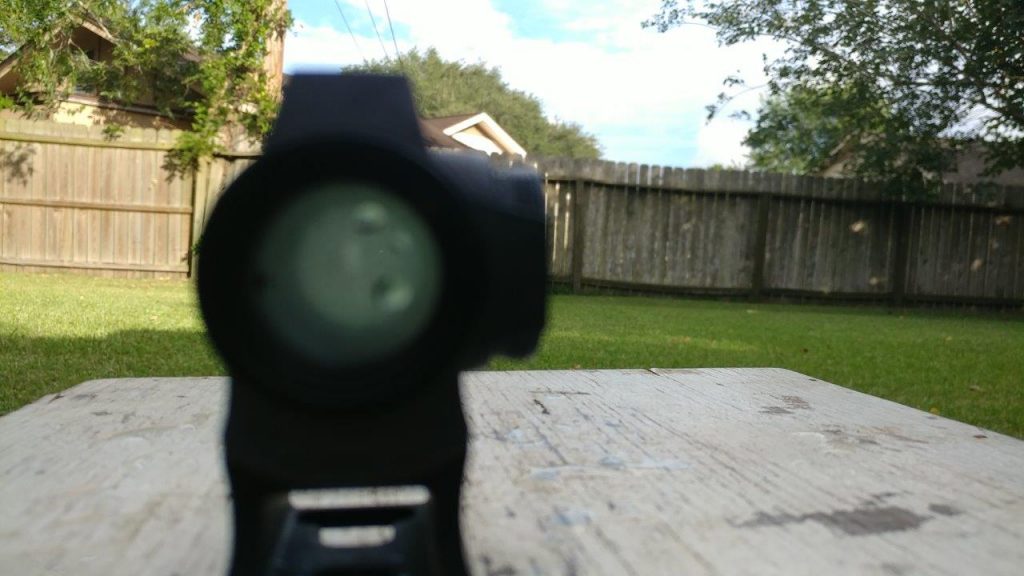
Gold Dot (RED DOT): Completely blurred window, but the dot was still visible floating inside the optic. Though it is hard to see in the photo, to the eye it was bright and visible, if not a bit fuzzy. With both eyes open, this optic would perform as an OEG despite the fogged lenses.
Rainstorm:
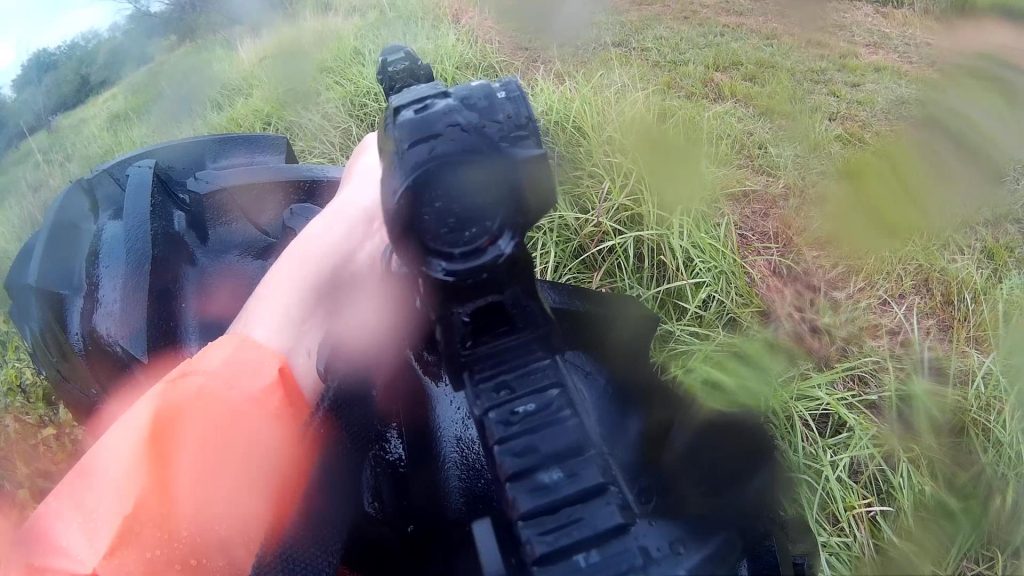
In conditions featuring pouring rain, certain optics can struggle. Rain can douse you in morning or at night. Optics can suffer the effects of condensation disrupting the sight picture. The interesting component of shooting in the rain is a constant “refresh rate” as rain collects and drains down the lens. Each individual rain drop acts as a micro lens on your optic, bending and moving light in unique ways. Having shot in full rain recently, it reminded me of the challenges present for glasses wearers. Not only are you managing poor resolution on your glasses, but also your optics. That’s three separate lenses that can collect condensation. Keep this in mind for all the four eyes in the crowd. I am you. It sucked.
To simulate rain, I simply sprayed the optics until water beaded off the front and rear lenses and then I shot the photos.

Wet, but still sexy.
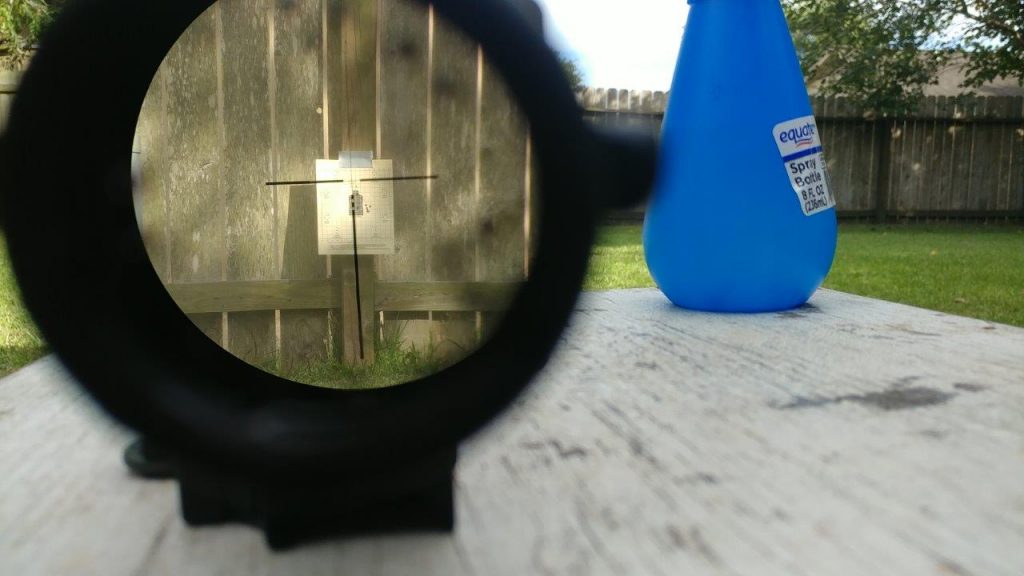
ACOG: Good target fidelity. Some rain drop shadows. Largely a non-issue as the rain drops were not in focus.
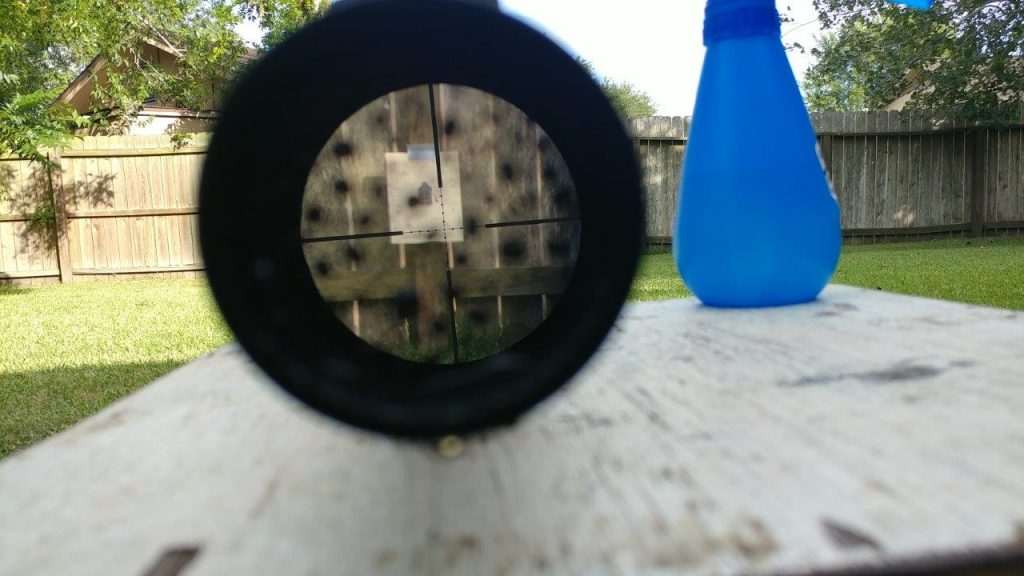
Variable optic: Fair target fidelity. More pronounced shadows on lens. They were, again, not in focus so the shooter can look past them without much issue.
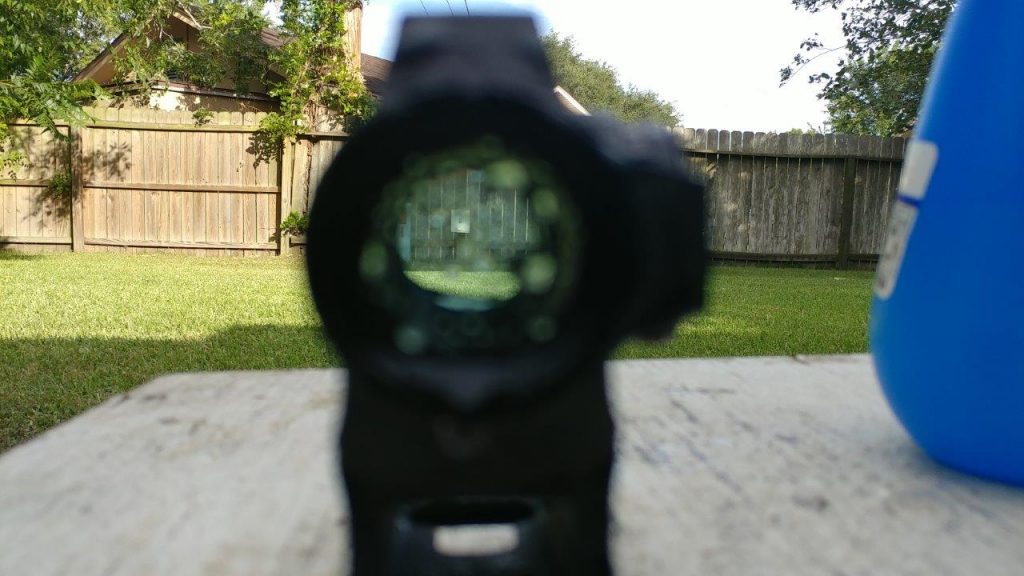
Gold Dot: Fair target fidelity. Shooting both eyes open allowed the eye to look past the collected rain drops and the dot was bright (brighter than it appeared in the photos).
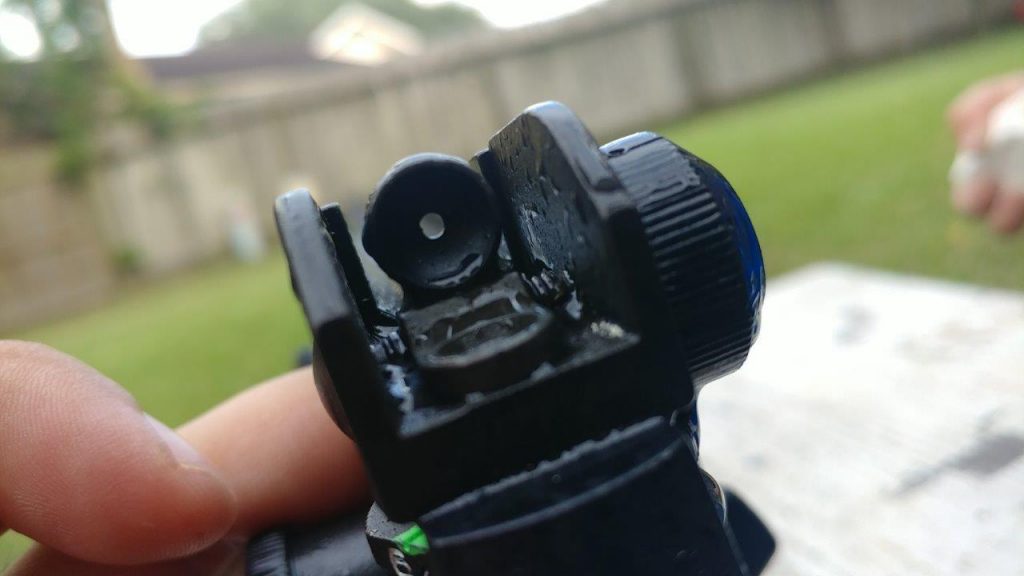
Irons: Good target fidelity. With enough rain, and the small peep could be distorted with a rain drop. Solution? Purse lips. Blow.
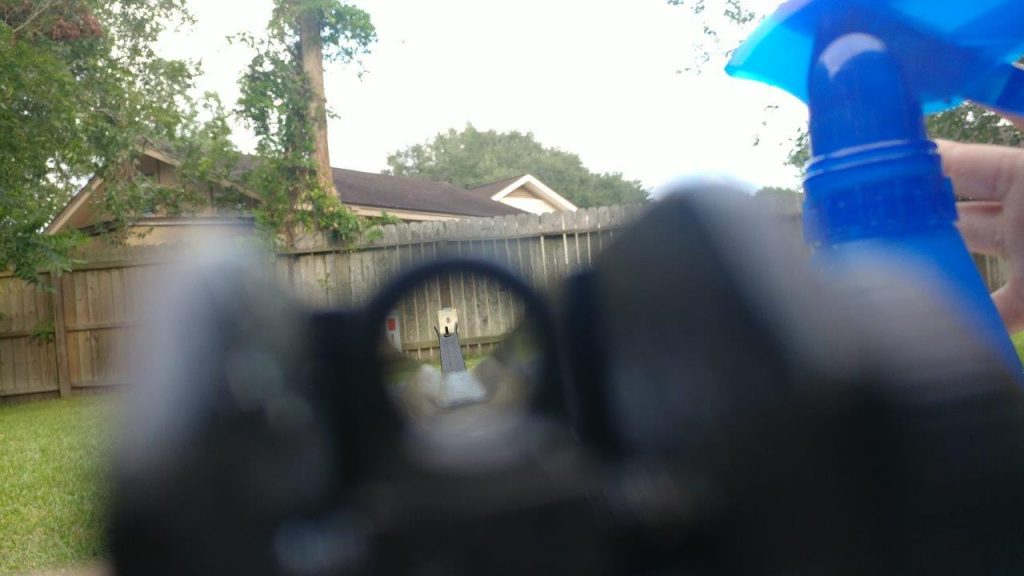
Irons: Perfect Target Fidelity. No amount of water spray could disrupt the sight picture using the large 0-200 aperture.
Low Light Rain with Weapon-Light:
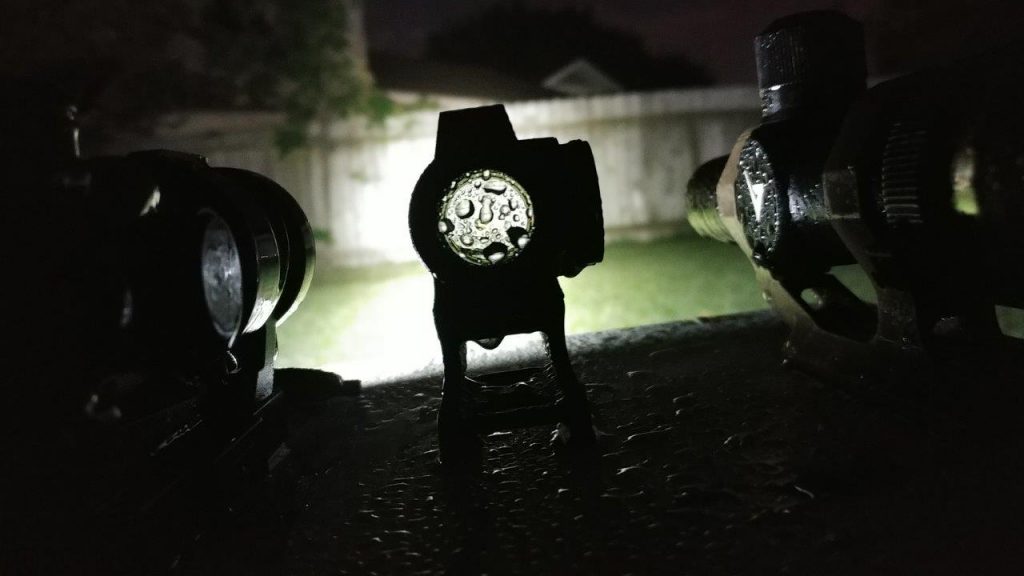
Rain can occur in at the worst times. How do these optics perform with a weapon-light in wet conditions? This was a challenging photo shoot, so please see the descriptions to better understand the characteristics of each scenario. For the most part, the brightness of the weapon light gave similar fidelity to daylight rain conditions. Of note, the illumination of the variable optic appeared to be captured by the rain drops. However, peering past the red raindrops give a sight picture with similar fidelity to daytime rain conditions.
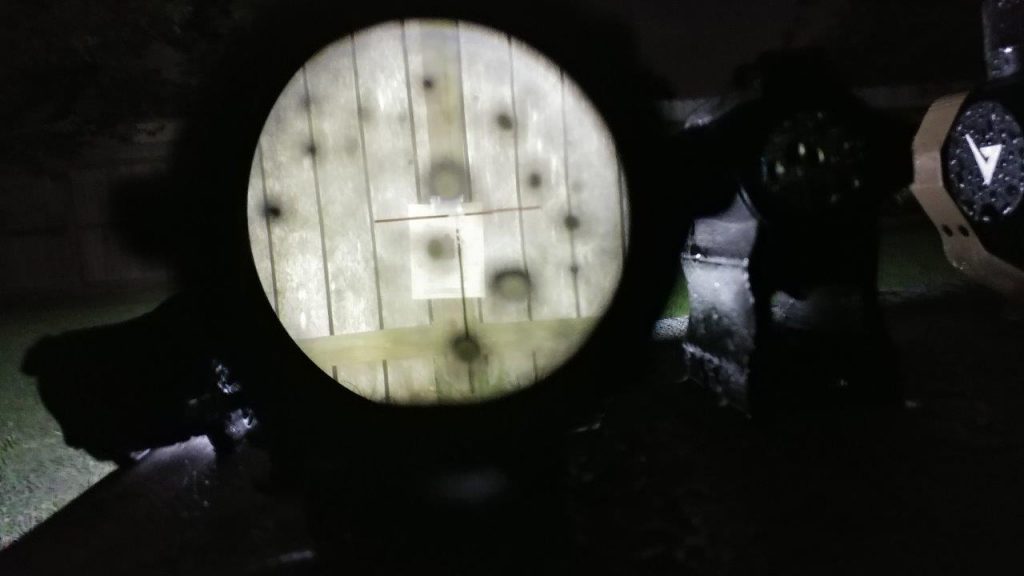
ACOG: Good target fidelity. To the human eye, the image was clearer than the photo. rain drop shadows present. Easy to look past shadows and focus on target.
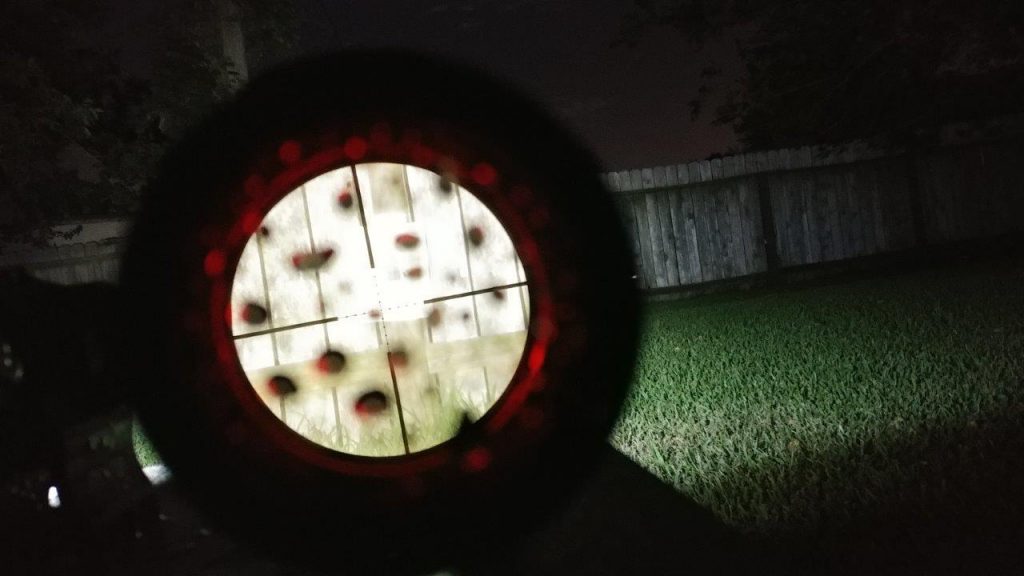
Variable: Fair target fidelity. Without illumination, the variables performance with similar to the ACOG with slightly more raindrop shadow. With illumination on, the raindrops each collected spilled red light and became red/black blobs. Focusing on the target allowed the shooter to look past the blobs.
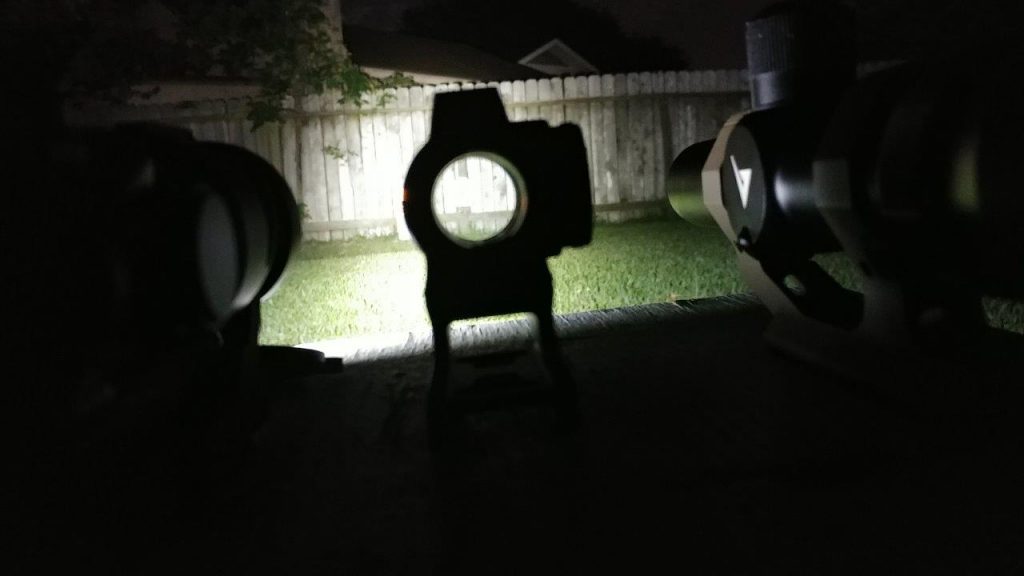
Red dot: Fair target fidelity. Again, when looking through the optic, the rain drops distorted the target depending on head position. However, when shooting using both eyes open and a target focus, these issues disappeared and the dot optic allowed good target fidelity when used as designed. The photo is not a good representation of the dot performance. The dot was present to the human eye.
Another important point to consider is that mini red dot sights can collect water in the battery area. This water continues to pool until the emitter is blocked by rain water or even a rain drop. I did not take a photo of this, but its pretty easy to disrupt mini red dot sights in this way.
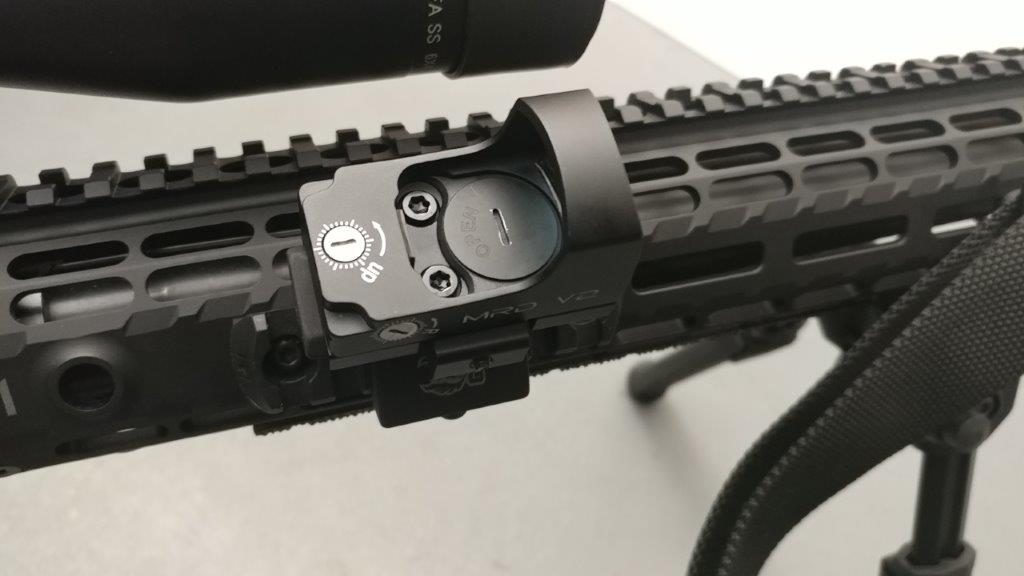
Rain and open emitters are a recipe for poor sight performance.
Wrapping Up:
Optics are incredibly important components for the modern rifleman. It is important to evaluate a setup based on your individualized needs; furthermore, it is important to evaluate that setup in multiple environments. We must not forget that redundancy is not dead. Often times we find ourselves looking at people who have “been there, done that”, and we look up to their experience and recommendations with good reason. What we must not forget is that their experience and environment may be entirely different from our own environment. Without careful evaluation of our own gear in adverse conditions, we may follow good advice that fails us when conditions are not to our expectations. Recently, I have been shooting in environments with high humidity. Bringing my red dot out to the garage for a photo shoot gave me the idea for this article as even the mundane transfer from a 75 degree home to the garage resulted in a fully fogged optic.
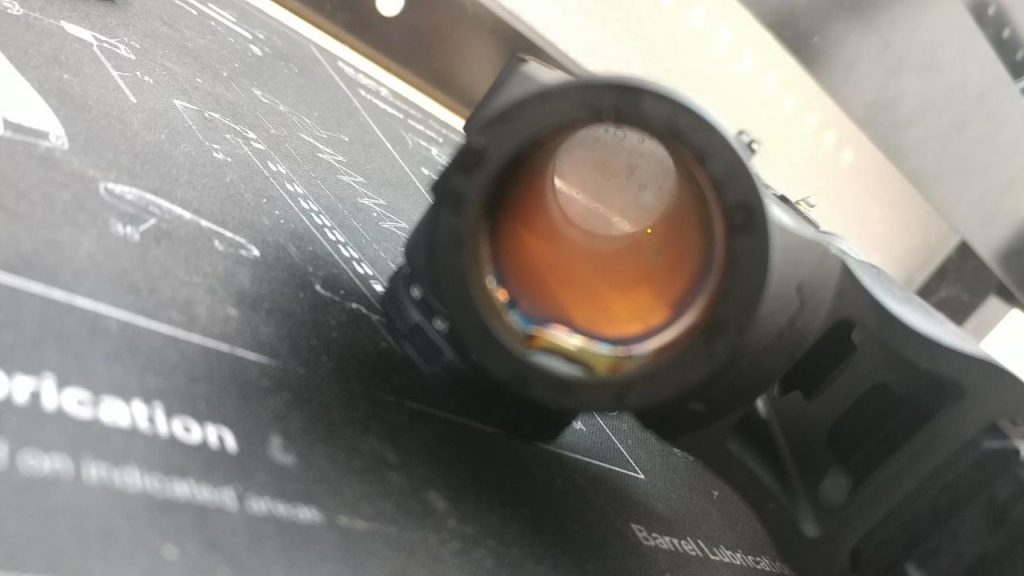
Without understanding the limitations of optics, we may be leaving performance on the floor when glass mis-behaves. Iron sights, un-surprisingly, offered the best sight picture in all adverse conditions tested. When conditions are normal, irons lag behind in performance of magnified optics and red dots. Recommendation: keep irons equipped to allow you to continue to shoot in adverse conditions, and consider a quality quick detach mount for your primary optic. If conditions take a turn for the worse, detach the optic and stow it until conditions normalize. Another recommendation: consider 45 degree offset iron sights in addition to your primary optic.
What happens if you drop your optic in the mud?
Tune in to TNR for this in the future.





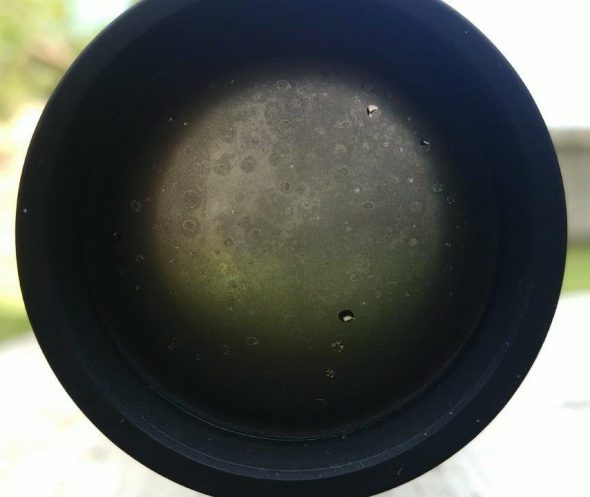


Really great article, makes me rethink stuff.
Great post! I remember Kyle Defoor doing something similar a while back with pretty much the same result. It’s definitely an argument for maintaining some proficiency with irons, especially if you have to keep a red dot. Of course…you’d still have to remove the RDS.
QD mounts are still my favorite too. I have a few non QD but I really like my GG&G QD mounts.
Just finished reading the article and had the idea to go grab my DD M4A1 with the Eotech 553 out of the bedroom. Inside temp: 71 deg; Outside temp: 97 deg (BUT with a seriously low humidity index here in central Texas). So, NO change as expected…
Awesome, i envy the people who live without humidity. Do try it again after a rainstorm and check results. Ilya (darklordofoptics) noted that some brands do feature hydrophobic coatings, but to my knowledge I had none of the optics I tested had any of these coatings.
Lothaen,
Glad you addressed environmental conditions vs optics. I would like to add an annoyance of mine in the “optic” arena: Eye Protection.
I often have the fogging condition and/or rain splattered lenses with my eyepro. Every bit a PITA as environmentally obscured optics can be. If one is using eye protection that utilizes corrective lens inserts you get a double whammy….the eyepro lenses may fog ALONG with the corrective lens inserts ! In the scheme of life it is a small issue.
Seeing as the bulk of citizens wear corrective lenses perhaps a “review” of eye protection available to shooters could be considered ?
Thank you for this well-written, thought provoking essay.
Appreciate the input. I wear corrected RX for eye protection from Rudy Project. They fogged, were beaded with water, and generally became miserable. I will see if there are any products I can try to reduce fogging of my glasses / eye pro.
https://www.outdoors.org/articles/amc-outdoors/cut-the-cat-crap-do-anti-fogging-treatments-really-work
A selection of anti-fog solutions (not the marketing BS, but in a literal sense – they’re liquids) as a starting point
Thanks for your reply and I will be testing some products soon.
The results you published here are very valid and eye-opening to many shooters, I am sure. That said, from a military standpoint, these concerns are (counter-intuitively) non-issue, thanks to the proliferation of eye protection, which like optics, are susceptible to fogging and foreign media occlusion.
To the former, there’s solutions applied to all viewing surfaces which will alleviate fogging for long enough for you to get down time to re-apply them. Perhaps multiple times over.
You’re totally right about the offset irons, too. If it’s your private fighting rifle, get them. That said, offset irons aren’t likely to make it into issued gear any time soon, especially now with ambidextrous shooting being all the rage (perhaps for good reason – firing from cover).
So to all those who know they’re walking into a fight, wipe your eye-pro and optics with anti-fog. There’s no getting around it.
None of my AR-style weapons have mounts for optics that aren’t removable with more than two flicks of my thumb. Irons aren’t susceptible to any of optics’ failures.
If I have to shoot I want to win, period.
Ex-Marine infantry officer, 8 years.
I live in Minnesota. We have humidity in the hot, with all the issues you noted. But we also have humidity in the cold, and of course we also have wicked cold (…”but it’s a dry cold”)
This complicates the optics issue by another order of magnitude, at least.
Weapon in 68F house then run out into 20F or -20? You could have some problems. Bring a cold weapon back inside? Your optics will not have droplets, but puddles, and will keep condensing atmospheric moisture as long as they are cold. Cold enough and they will actually be frost covered for some time. …run back outside? Oh, well then your wet optic will be covered in ice.
Beyond the condensation and fogging issues, many optics have operating ranges that barely go below freezing, if that. We are well below that for months at a time.
How many people in cold climates imagine/assume they will use an optics equipped weapon in a winter defensive scenario? … yet have never checked to even see if their optic will operate in winter temps? …and how about their actual weapon and system. How many have even shot/operated their weapon in the winter?
In my neck of the woods any question of optics in adverse condition (or even weapons in adverse conditions) has to include all of these considerations.
One of the reasons I bought my DI Optics RV-1’s was that they were truly Mil-STD certified. This not only meant extreme shock resistance, and waterproof, but my shopping requirements included certified operating ranges to -22F. When you shop with that spec in mind, the DI optics were the only things below $700 that met that standard. Too bad they could not get a decent distributor in the USA, and that most testing that people read never considers the realities that many in the USA should really be considering.
Love what you do. I learn so much. Thanks.
Thank you for the awesome comment!
I’m late to the party but great article; just what I was looking for. I have had a bad run of foggy optics lately. I sent my Primary Arms prism back and they said it had a nitrogen leak. It was fogging really bad out of the blue. Now my new (to me) ACOG is doing the same thing. My Sig range finder has always done it. What’s weird is my thermal monocular seems unaffected. I suspect it’s going from AC to hot/humid Georgia outside weather, or so I hope…
I’m glad to hear I’m not the only one who battles humidity and optics. I do use an anti fog spray but may check out the mentioned ‘cat crap’. It seems to come up in discussions.
Have you tried it yet OP? Any new insights?